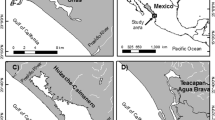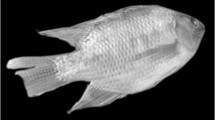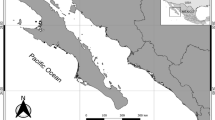Abstract
Mercury (Hg) was measured in the muscle, liver, and gonads of Haemulopsis elongatus and Pomadasys macracanthus from Mazatlán (SE Gulf of California) to determine the relationships of the hepatosomatic index (HSI) and gonadosomatic index (GSI) of fish with Hg concentrations in the corresponding tissues. Health risk to consumers was assessed by using the hazard quotient (HQ), considering the average rate of fish consumption in Mexico and Hg concentration in the edible tissue. In H. elongatus, the highest Hg levels were measured in the liver (3.748 μg g−1); in P. macracanthus, the highest Hg concentration was quantified in the muscle (0.574 μg g−1). In P. macracanthus, the HSI was negatively correlated with Hg concentration in the liver; in H. elongatus, there was also a negative relationship between Hg levels in gonads and the GSI. Mean HQ values in Haemulopsis elongatus (0.005) and Pomadasys macracanthus (0.002) were below the value (HQ ≥ 1) of concern. The significant reduction of HSI and GSI with Hg increase in the liver and gonads may suggest that Hg bioaccumulation in these fish shows adverse physiological effects. Though HQ values in both species were below the unit, i.e., the consumption of the muscle from this species does not represent a health risk, it is necessary to carry out surveys of fish consumption rates in coastal areas of Mexico to do a more precise health risk assessment associated to Hg intake.


Similar content being viewed by others
Data availability
Not applicable.
References
Abtahi, M., Fakhri, Y., Conti, G. O., Keramati, H., Zandsalimi, Y., Bahmani, Z., et al. (2017). Heavy metals (As, Cr, Pb, Cd and Ni) concentrations in rice (Oryza sativa) from Iran and associated risk assessment: a systematic review. Toxin Reviews, 36(3), 331–341.
Agah, H., Leermakers, M., Gao, Y., Fatemi, S. M. R., & Mohseni-Katal, M. (2010). Mercury accumulation in fish species from the Persian Gulf and in human hair from fishermen. Environmental Monitoring and Assessment, 169, 203–216.
Balart, E. F., Castro-Aguirre, J. L., & Torres-Orozco, R. (1992). Ictiofauna de las bahías de Ohuira, Topolobambo y Santa María, Sinaloa, México. Investigaciones Marinas CICIMAR, 7(2), 91–103.
Boening, D. W. (2000). Ecological effects, transport, and fate of mercury: a general review. Chemosphere, 40, 1335–1351.
Branch, T. A., Watson, R., Fulton, E. A., Jennings, S., McGilliard, C. R., Pablico, G. T., Ricard, D., & Tracey, S. R. (2010). The trophic fingerprint of marine fisheries. Nature, 468, 431–435.
Butchart, S. H. M., Walpole, M., Collen, B., Van Strien, A., Scharlemann, J. P. W., Almond, R. E. A., et al. (2010). Global biodiversity: indicators of recent declines. Science, 328, 1164–1168.
Cardoso-Mohedano, G., Páez-Osuna, F., Amezcua-Martínez, F., Ruiz-Fernández, A. C., Ramírez-Reséndiz, G., & Sánchez-Cabeza, J. (2016). Combined environmental stress from shrimp farm and dredging releases in a subtropical coastal lagoon (SE Gulf of California). Marine Pollution Bulletin, 104, 83–91.
Castro-Rodrigues, A. P., Oliveira-Maciel, P., Cavalcanti-Pereira, L. C., Pereira-Almosny, N. R., Andreata, J. V., Bidone, E. D., et al. (2011). Relationship between mercury concentrations in the blood with that in the muscle of four estuarine tropical fish species, Rio de Janeiro state, Brazil. Bulletin of Environmental Contamination and Toxicology, 86, 357–362.
Chouvelon, T., Warnau, M., Churlaud, C., & Bustamante, P. (2009). Hg concentrations and related risk assessment in coral reef crustaceans, molluscs and fish from New Caledonia. Environmental Pollution, 157, 331–340.
Cifuentes-Lemus, J. L., Torres-García, P., & Frías, M. (1995). El Océano y sus Recursos, IX. La Pesca. México, DF: Editorial Fondo de Cultura Económica (FCE).
Cortés-Gómez, A. A., Romero, D., & Girondot, M. (2017). The current situation of inorganic elements in marine turtles: a general review and meta-analysis. Environmental Pollution, 229, 567–585.
Dang, F., & Wang, W.-X. (2012). Why mercury concentration increases with fish size? Biokinetic explanation. Environmental Pollution, 163, 192–198.
Devi, M., Gopal, V., & Ratna, G. (1991). Liver somatic index of Channa striatus as a biomonitoring tool of heavy metal and pesticide toxicity. Journal of Ecotoxicological and Environmental Monitoring, 1(2), 135–141.
Dijkstra, J. A., Buckman, K. L., Ward, D., Evans, D. W., Dionne, M., & Chen, C. Y. (2013). Experimental and natural warming elevates mercury concentrations in estuarine fish. PLoS One, 8(13), e58401.
Evers, D. C., Keane, S. E., Basu, N., & Buck, D. (2016). Evaluating the effectiveness of the Minamata Convention on mercury: principles and recommendations for next steps. Science of the Total Environment, 569, 888–903.
Feng, X., Li, P., Qiu, G., Wang, S., Li, G., Shang, L., Meng, B., Jiang, H., Bai, W., Li, Z., & Fu, X. (2008). Human exposure to methylmercury through rice intake in mercury mining areas, Guizhou Province, China. Environmental Science and Technology, 42(1), 326–332.
Fischer, W., Krupp, F., Schneider, W., Sommer, C., Carpenter, K. E., & Niem, V. H. (1995). Guía FAO para la identificación de especies para los fines de la pesca. Pacífico centro-oriental, vol III. Vertebrados. Roma: FAO.
Fréry, N., Maury-Brachet, R., Maillot, E., Deheeger, M., De Mérona, B., Boudou, A., et al. (2001). Gold-mining activities and mercury contamination of native amerindian communities in French Guiana: key role of fish in dietary uptake. Environmental Health Perspectives, 109(5), 449–456.
Froese, R., & Pauly, D. (Eds.) (2019). FishBase. World Wide Web electronic publication. www.fishbase.org, version (12/2019). Accesed 25 August 2020.
Gbogbo, F., Arthur-Yartel, A., Bondzie, J. A., Dorleku, W. P., Dadzie, S., Kwansa-Bentum, B., et al. (2018). Risk of heavy metal ingestion from the consumption of two commercially valuable species of fish from the fresh and coastal waters of Ghana. PLoS ONE, 13(3), 0194682.
Gochfeld, M. (2003). Cases of mercury exposure, bioavailability, and absorption. Ecotoxicology and Environmental Safety, 56, 174–179.
Gold-Bouchot, G., Rubio-Piña, J., Montero-Muñoz, J., Ramirez-Miss, N., Echeverría-García, A., Patiño-Suárez, V., et al. (2017). Pollutants and biomarker responses in two reef fish species (Haemulon aurolineatum and Ocyurus chrysurus) in the southern Gulf of Mexico. Marine Pollution Bulletin, 116, 249–257.
Health Canada. (2004). Federal contaminated site risk assessment in Canada part I: guidance on human health preliminary quantitative risk assessment (PQRA), Cat. H46-2/04-367E. Available at http://www.hc-sc.gc.ca/ewh-semt/contamsite/risk-risque-eng.php. Accesed 26 August 2020.
Lara-Mendoza, R. E., & Amezcua, F. (2018). Geographic variation in the reproductive ecology of the Panamic grunt in the southeastern Gulf of California. Marine and Coastal Fisheries: Dynamics, Management, and Ecosystem Science, 10, 357–367.
Larose, C., Canuel, R., Lucotte, M., & Di Giulio, R. T. (2008). Toxicological effects of methylmercury on walleye (Sander vitreus) and perch (Perca flavescens) from lakes of the boreal forest. Comparative Biochemistry and Physiology, Part C, 147(2), 139–149.
López, M. I. (1981). Los “roncadores” del género Pomadasys (Haemulopsis) [Pisces: Haemulidae] de la costa Pacífica de Centro América. Revista de Biología Tropical, 29(1), 83–94.
Loring, D. H., & Rantala, R. T. (1995). Manual for the geochemical analyses of marine sediments and suspended particulate matter. Reference methods for marine pollution Studies No. 63
M.E.S.L. (1997). Standard operating procedures (pp. 66). Marine Environmental Studies Laboratory, International Atomic Energy Agency. Agency Monaco
Magalhães, M. C., Costa, V., Menezes, G. M., Pinho, M. R., Santos, R. S., Monteiro, L. R., et al. (2007). Intra- and inter-specific variability in total and methylmercury bioaccumulation by eight marine fish species from the Azores. Marine Pollution Bulletin, 54, 1654–1662.
Marrugo-Negrete, J., Olivero-Verbel, J., Lans-Ceballos, E., & Norberto-Benítez, L. (2008). Total mercury and methylmercury concentrations in fish from the Mojana region of Colombia. Environmental Geochemistry and Health, 30, 21–30.
Martínez-Salcido, A. I., Ruelas-Inzunza, J., Gil-Manrique, B., Nateras-Ramirez, O., & Amezcua, F. (2018). Mercury levels in fish for human consumption from the southeast Gulf of California: tissue distribution and health risk assessment. Archives of Environmental Contamination and Toxicology, 74, 273–283.
Metian, M., Warnau, M., Chouvelon, T., Pedraza, F., Rodriguez y Baena, A. M., & Bustamante, P. (2013). Trace element bioaccumulation in reef fish from New Caledonia: influence of trophic groups and risk assessment for consumers. Marine Environmental Research, 87-88, 26–36.
Moody, J. R., & Lindstrom, R. N. (1977). Selection and cleaning of plastic containers for storage of trace element samples. Analytical Chemistry, 49, 2264–2267.
Moreno-Pérez, I. J. (2019). Estructura de la comunidad de peces en la laguna costera de Navachiste, Sinaloa, México. Masters Thesis. Centro de Investigaciones Biológicas del Noroeste, S.C.
Moyle, P. B., & Cech, J. J. (2000). Fishes: an introduction to ichthyology. Saddle River: Prentice-Hall.
Páez-Osuna, F., & Osuna-Martı́nez, C. C. (2015). Bioavailability of cadmium, copper, mercury, lead, and zinc in subtropical coastal lagoons from the Southeast Gulf of California using mangrove oysters (Crassostrea corteziensis and Crassostrea palmula). Archives of Environmental Contamination and Toxicology, 68, 305–316.
Pauly, D., & Watson, R. (2005). Background and interpretation of the ‘Marine Trophic Index’ as a measure of biodiversity. Philosophical Transactions of the Royal Society B, 360, 415–423.
Pauly, D., Christensen, V., & Walters, C. (2000). Ecopath, ecosim, and ecospace as tools for evaluating ecosystem impacts on marine ecosystems. ICES Journal of Marine Science, 57, 697–706.
Pyle, G. G., Rajotte, J. W., & Couture, P. (2005). Effects of industrial metals on wild fish populations along a metal contamination gradient. Ecotoxicology and Environmental Safety, 61(3), 287–312.
Rábago-Quiroz, C. H., López-Martínez, J., Valdez-Holguín, J. E., & Nevárez-Martínez, M. O. (2011). Distribución latitudinal y batimétrica de las especies más abundantes y frecuentes en la fauna acompañante del camarón del Golfo de California, México. Revista de Biología Tropical, 59(1), 255–267.
Rábago-Quiroz, C. H., López-Martínez, J., Valdéz-Olguín, J. E., Nevárez-Martínez, M. O., & Acevedo-Cervantes, A. (2012). Fish assemblages in the bycatch of bottom shrimp trawls on the west side of the Gulf of California, Mexico. Marine Biology Research, 8, 865–876.
Ram, R. N., & Sathyanesan, A. G. (1987). Histopathological and biochemical changes in the liver of a teleost fish, Channa punctatus (Bloch) induced by a mercurial fungicide. Environmental Pollution, 47, 135–145.
Ruelas-Inzunza, J., Meza-López, G., & Páez-Osuna, F. (2008). Mercury in fish that are of dietary importance from the coasts of Sinaloa (SE Gulf of California). Journal of Food Composition and Analysis, 21, 211–218.
Ruelas-Inzunza, J., Páez-Osuna, F., Ruiz-Fernández, A. C., & Zamora-Arellano, N. (2011). Health risk associated to dietary intake of mercury in selected coastal areas of Mexico. Bulletin of Environmental Contamination and Toxicology, 86, 180–188.
Ruelas-Inzunza, J., Sánchez-Osuna, K., Amezcua-Martínez, F., Spanopoulos-Zarco, P., & Manzano-Luna, L. (2012). Mercury levels in selected bycatch fish species from industrial shrimp-trawl fishery in the SE Gulf of California. Marine Pollution Bulletin, 64, 2857–2859.
Saei-Dehkordi, S. S., Fallah, A. A., & Nematollahi, A. (2010). Arsenic and mercury in commercially valuable fish species from the Persian Gulf: influence of season and habitat. Food and Chemical Toxicology, 48, 2945–2950.
SAGARPA. Secretaría de Agricultura, Ganadería y Desarrollo Rural Pesca y Alimentación. (2013). Anuario estadístico de acuacultura y pesca (p. 299). México: Comisión Nacional de Acuacultura y Pesca.
Saxena, R. (1986). Comparative studies on the gonadosomatic index in two bottom feeder teleosts. Indian Journal of Phyisical and Natural Sciences, 6, 39–97.
Schlacher, T. A., & Wooldridge, T. H. (1996). Patterns of selective predation by juvenile, benthivorous fish on estuarine macrofauna. Marine Biology, 125, 241–247.
Signa, G., Mazzola, A., Tramati, C. D., & Vizini, S. (2017). Diet and habitat use influence Hg and Cd transfer to fish and consequent biomagnification in a highly contaminated area: Augusta Bay (Mediterranean Sea). Environmental Pollution, 230, 394–404.
Sindhe, V. R., & Kulkarni, R. S. (2004). Gonadosomatic and hepatosomatic indices of the freshwater fish Notopterus notopterus (Pallas) in response to some heavy metal exposure. Journal of Environmental Biology, 25(3), 365–368.
Soto-Jiménez, M., & Páez-Osuna, F. (2001). Cd, Cu, Pb, and Zn in lagoonal sediments from Mazatlán harbor (SE Gulf of California): bioavailability and geochemical fractioning. Bulletin of Environmental Contamination and Toxicology, 66(3), 350–356.
Spanopoulos-Zarco, P., Ruelas-Inzunza, J., Meza-Montenegro, M., Osuna-Sánchez, K., & Amezcua-Martínez, F. (2014). Health risk assessment from mercury levels in bycatch fish species from the coasts of Guerrero, Mexico (Eastern Pacific). Bulletin of Environmental Contamination and Toxicology, 93, 334–338.
Stevenson, R. D., & Woods, W. A. (2006). Condition indices for conservation: new uses for evolving tools. Integrative and Comparative Biology, 46(6), 1169–1190.
US EPA. (1989). Risk assessment guidance for superfund. Human health evaluation manual (Part A). Interim final, vol. 1. Environmental Protection Agency, Washington, EPA/540/1-89/002
US EPA. (2002). Region 9 preliminary remediation goals https://www.epa.gov/eg/toxic-and-prioritypollutants-under-clean-water-act. Accesed 28 August 2020.
Voegborlo, R. B., & Adimado, A. A. (2010). Total mercury distribution in different fish species representing different trophic levels from the Atlantic coast of Ghana. Journal of Science and Technology, 30(1), 1–9.
Wilk, A., Kalisińska, E., Kosik-Bogacka, D. I., Romanowski, M., Rózański, J., Ciechanowski, K., et al. (2017). Cadmium, lead and mercury concentrations in pathologically altered human kidneys. Environmental Geochemistry and Health, 39, 889–899.
Zamora-Arellano, N. Y., Ruelas-Inzunza, J., García-Hernández, J., Ilizaliturri-Hernández, C. A., & Betancourt-Lozano, M. (2017). Linking fish consumption patterns and health risk assessment of mercury exposure in a coastal community of NW Mexico. Human and Ecological Risk Assessment: An International Journal, 23(6), 1505–1521.
Acknowledgments
We thank C. Ramírez-Jáuregui for the bibliographic support and M.Sc. Karla Guadalupe Sánchez-Osuna for the laboratory help.
Funding
This study was funded by Programa de Mejoramiento del Profesorado (project PROMEP/103.5/13/9366).
Author information
Authors and Affiliations
Corresponding author
Ethics declarations
Conflict of interest
The authors declare that they have no conflict of interest.
Ethics approval
Not applicable.
Consent to participate
Not applicable.
Consent for publication
Not applicable.
Code availability
Not applicable.
Additional information
Publisher’s note
Springer Nature remains neutral with regard to jurisdictional claims in published maps and institutional affiliations.
Rights and permissions
About this article
Cite this article
Ramos-Osuna, M., Patiño-Mejía, C., Ruelas-Inzunza, J. et al. Bioaccumulation of mercury in Haemulopsis elongatus and Pomadasys macracanthus from the SE Gulf of California: condition indexes and health risk assessment. Environ Monit Assess 192, 704 (2020). https://doi.org/10.1007/s10661-020-08599-2
Received:
Accepted:
Published:
DOI: https://doi.org/10.1007/s10661-020-08599-2




